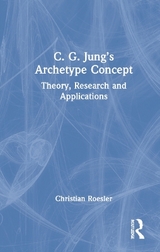C. G. Jung’s Archetype Concept
The book also explores how the concept has further developed as a result of research and, for the first time, integrates findings from anthropology, human genetics, and the neurosciences. Based on these contemporary insights, Roesler also makes a compelling argument for why some of Jung’s views on the concept should be comprehensively revised.
Offering new insights on foundational Jungian topics like the collective unconscious, persona, and shadow, C. G. Jung’s Archetype Concept is of great interest to Jungian students, analysts, psychotherapists, and scholars.
ChristianRoesler is a professor of Clinical Psychology at the Catholic University of Applied Sciences in Freiburg, Germany, and Lecturer of Analytical Psychology at the University of Basel, Switzerland. He is also a Jungian psychoanalyst in private practice in Freiburg and a member of the faculty of the C. G. Jung-Institutes in Stuttgart and Zurich.
1. Introduction
2. The Classic Definition and Theory of Jung’s Concept of Archetypes
2.1 Definition
2.2 Archetypes in the Life of the Individual
2.3 Manifestations of Archetypes
2.4 The Collective Unconscious
2.5 The Individuation Process
2.5.1 The Two Halves of Life and the Mid-life Crisis
2.5.2 The Persona
2.5.3 The Shadow
2.5.4 The Image of the Soul: Anima and Animus
2.5.5 Digression: Criticism of the Anima/Animus concept and contemporary conceptions
2.5.6 The Old Sage and The Great Mother (the Mana-Personalities)
2.5.7 The Self
2.5.8 The Individuation process
2.6 Classical works on the core archetypes
2.7 Further classical investigations of archetypes from Jung’s successors
2.8 On The History of the Term
2.9 Parallel concepts in general psychoanalysis
2.10 Parallels to the collective unconscious in other schools of psychotherapy
3. Criticism of the classic concept of the archetype and expansions
3.1 Problems and Contradictions in the Jungian concept of archetypes
3.1.1 Biological Definition
3.1.2 Empirical Statistical Definition
3.1.3 Transcendental Definition
3.1.4 Cultural Psychological Behaviour
3.2 Expansions of the archetype concept from Jung’s direct pupils
3.2.1 Michael Fordham’s theory of the process of Deintegration and Reintegration as an extension of Jung’s theory of the Self
3.2.2 Erich Neumann’s ‘History and origins of consciousness’
3.2.3 The Archetypal Psychology of James Hillman
4. Research on the Archetype concept and resulting further developments of the theory
4.1 Scientifically Verifiable Elements of Jung’s Term ‘Archetype’
Empirical Evidence for Archetypes
4.2.1 Association studies: Corresponding inter-individual core complexes
4.2.2 Proof for inherent mental structures
4.2.3 Anthropological Research
4.2.2 Research on altered states of consciousness
4.2.5 Experimental Studies on archetypal memory
4.2.6 Research with the archetype concept
4.2.7 Discussion of the empirical evidence
4.3 Explanatory approaches for the emergence and the transference of archetypes
4.3.1 State-of-the-art in Human genetics and Epigenetics
4.3.2 Endophenotypes
4.3.3. Concepts and Research Results from Gestalt Psychology, cognitive science, and Neuroscience
4.3.4. Archetypes as Emerging Structures
4.3.5 Mirror Neurons and the ‘inter-subjective shared space’
4.3.6 A Reformulation of the Archetype Concept
4.4. Research on the collective unconscious, in the sense of an unconscious, interpersonal connection
5. Applications of Archetype Theory
5.1 The Amplification Method
5.2 Clinical Application
5.2.1 Character – Identity – Biography
5.2.2. The role of archetypes in the psychotherapeutic process
5.2.3 Case Study of therapeutic work with archetypal dream elements
5.2.4 Archetypal Transference
5.2.5 The Archetype of the Wounded Healer as an orientation for a psychotherapeutic approach
5.2.6 Using the archetype concept to explain the dynamic in couple relationships and its use in couple therapy
5.2.7 The use of the archetype concept in therapeutic/encounter groups: an example from the men’s movement
5.3. Applications in Cultural Studies
5.3.1 Cultural psychology: analysis of mythological narratives
5.3.2 Archetypes in political psychology
6. What is the state of archetype theory? – a tentative conclusion
Index
| Erscheinungsdatum | 30.12.2021 |
|---|---|
| Zusatzinfo | 3 Line drawings, black and white; 3 Illustrations, black and white |
| Verlagsort | London |
| Sprache | englisch |
| Maße | 129 x 198 mm |
| Gewicht | 453 g |
| Themenwelt | Geisteswissenschaften ► Psychologie ► Psychoanalyse / Tiefenpsychologie |
| Medizin / Pharmazie ► Medizinische Fachgebiete ► Psychiatrie / Psychotherapie | |
| ISBN-10 | 0-367-52805-3 / 0367528053 |
| ISBN-13 | 978-0-367-52805-8 / 9780367528058 |
| Zustand | Neuware |
| Haben Sie eine Frage zum Produkt? |
aus dem Bereich




